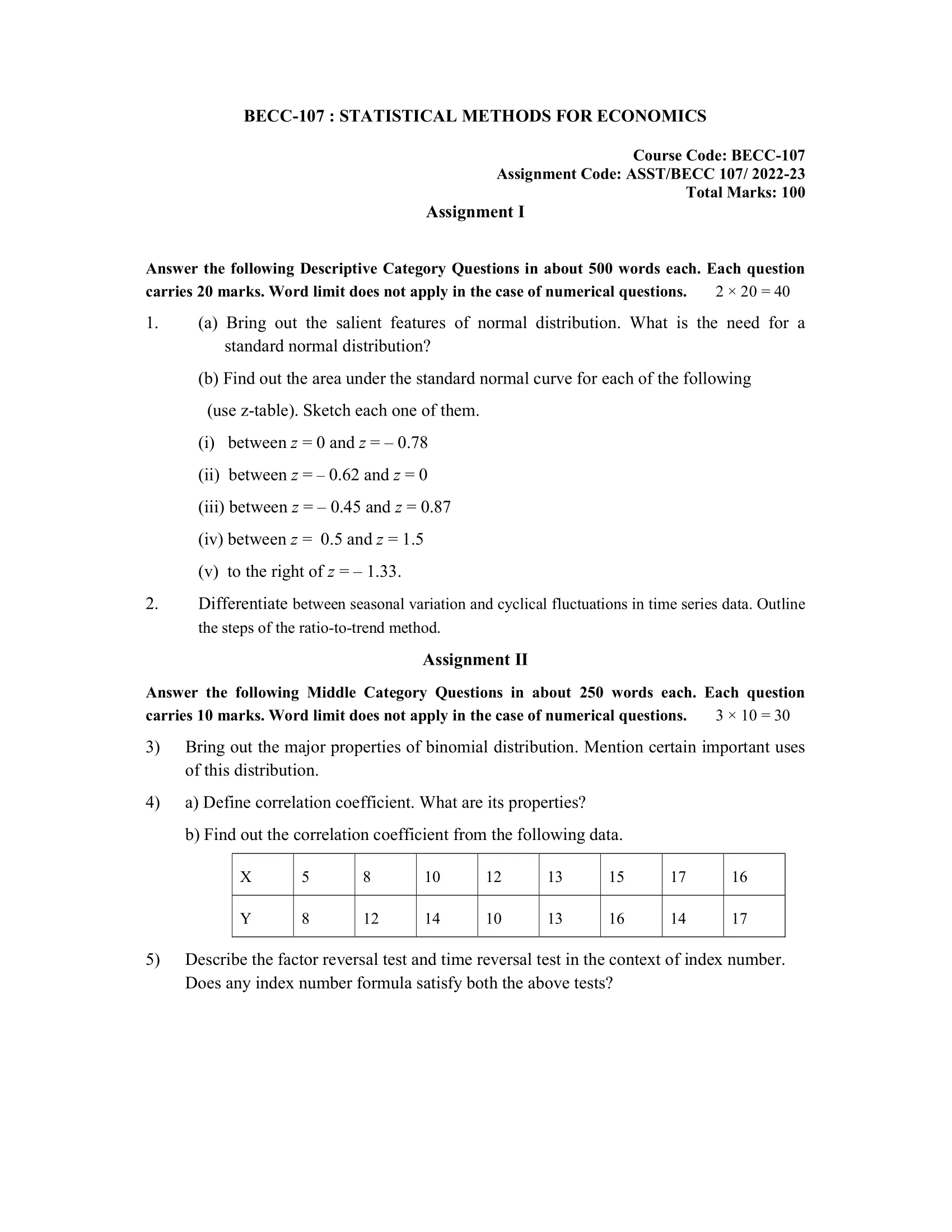
| Title | BECC-107: IGNOU BAG Solved Assignment 2022-2023 |
| University | IGNOU |
| Degree | Bachelor Degree Programme |
| Course Code | BECC-107 |
| Course Name | STATISTICAL METHODS FOR ECONOMICS |
| Programme Name | Bachelor of Arts (General) |
| Programme Code | BAG |
| Total Marks | 100 |
| Year | 2022-2023 |
| Language | English |
| Assignment Code | ASST/BECC 107/ 2022-23 |
| Last Date for Submission of Assignment: | For June Examination: 31st April For December Examination: 30th September |


Assignment I
Answer the following Descriptive Category Questions in about 500 words each. Each question carries 20 marks. Word limit does not apply in the case of numerical questions.
1. (a) Bring out the salient features of normal distribution. What is the need for a standard normal distribution?
Ans: Normal distribution, also known as Gaussian distribution or bell curve, is a continuous probability distribution that is widely used in many fields including natural sciences, social sciences, engineering, and economics. The normal distribution is defined by its mean (μ) and standard deviation (σ). The mean represents the center of the distribution and the standard deviation represents the spread of the distribution. The most important characteristic of the normal distribution is that it is symmetrical and has a bell-shaped curve.
Salient Features of Normal Distribution:
- Symmetrical: The normal distribution is symmetrical around its mean, meaning that if you split the distribution in half, the shape of the two halves is exactly the same.
- Unimodal: The normal distribution is unimodal, meaning that it has only one peak. The peak of the normal distribution is located at the mean.
- Continuous: The normal distribution is a continuous distribution, meaning that there are no gaps or jumps in the curve.
- Central Limit Theorem: One of the most important properties of the normal distribution is the central limit theorem. This theorem states that the sum of a large number of independent and identically distributed random variables will approach a normal distribution, regardless of the shape of the individual distributions.
- 68-95-99.7 Rule: The normal distribution has another important property known as the 68-95-99.7 rule. This rule states that 68% of the data falls within one standard deviation of the mean, 95% of the data falls within two standard deviations of the mean, and 99.7% of the data falls within three standard deviations of the mean.
The need for a Standard Normal Distribution:
A standard normal distribution is a normal distribution with a mean of 0 and a standard deviation of 1. The standard normal distribution is often used because it allows for easy comparison between different normal distributions. By converting a normal distribution to a standard normal distribution, it is possible to easily find the probability of a given event occurring. This is done by using a standard normal table or a z-score formula.
The standard normal distribution is also useful because it makes it possible to determine the proportion of data within any given interval. For example, if you know that a data set has a mean of 100 and a standard deviation of 10, you can convert the data to a standard normal distribution by subtracting the mean and dividing by the standard deviation. The result is a standard normal distribution with a mean of 0 and a standard deviation of 1.
(b) Find out the area under the standard normal curve for each of the following
(use z-table). Sketch each one of them.
(i) between z = 0 and z = – 0.78
Ans: To find the area under the standard normal curve between z = 0 and z = -0.78, we can use a standard normal table or a calculator that includes a standard normal cumulative distribution function. In a standard normal table, we look up the probabilities associated with each z-value and subtract the probability associated with the lower z-value from the probability associated with the higher z-value.
Using a standard normal table or calculator, we find that the area under the standard normal curve between z = 0 and z = -0.78 is approximately equal to 0.2948. This means that approximately 29.48% of the data in a standard normal distribution falls between z = 0 and z = -0.78.
Here is a sketch of the area under the standard normal curve between z = 0 and z = -0.78:
[Sketch of the standard normal curve with the area between z = 0 and z = -0.78 shaded]
(ii) between z = – 0.62 and z = 0
Ans: To find the area under the standard normal curve between z = -0.62 and z = 0, we can use a standard normal table or a calculator that includes a standard normal cumulative distribution function. In a standard normal table, we look up the probabilities associated with each z-value and subtract the probability associated with the lower z-value from the probability associated with the higher z-value.
Using a standard normal table or calculator, we find that the area under the standard normal curve between z = -0.62 and z = 0 is approximately equal to 0.3534. This means that approximately 35.34% of the data in a standard normal distribution falls between z = -0.62 and z = 0.
Here is a sketch of the area under the standard normal curve between z = -0.62 and z = 0:
[Sketch of the standard normal curve with the area between z = -0.62 and z = 0 shaded]
(iii) between z = – 0.45 and z = 0.87
Ans: To find the area under the standard normal curve between z = -0.45 and z = 0.87, we can use a standard normal table or a calculator that includes a standard normal cumulative distribution function. In a standard normal table, we look up the probabilities associated with each z-value and subtract the probability associated with the lower z-value from the probability associated with the higher z-value.
Using a standard normal table or calculator, we find that the area under the standard normal curve between z = -0.45 and z = 0.87 is approximately equal to 0.7382. This means that approximately 73.82% of the data in a standard normal distribution falls between z = -0.45 and z = 0.87.
Here is a sketch of the area under the standard normal curve between z = -0.45 and z = 0.87:
[Sketch of the standard normal curve with the area between z = -0.45 and z = 0.87 shaded]
(iv) between z = 0.5 and z = 1.5
Ans: To find the area under the standard normal curve between z = 0.5 and z = 1.5, we can use a standard normal table or a calculator that includes a standard normal cumulative distribution function. In a standard normal table, we look up the probabilities associated with each z-value and subtract the probability associated with the lower z-value from the probability associated with the higher z-value.
Using a standard normal table or calculator, we find that the area under the standard normal curve between z = 0.5 and z = 1.5 is approximately equal to 0.4332. This means that approximately 43.32% of the data in a standard normal distribution falls between z = 0.5 and z = 1.5.
Here is a sketch of the area under the standard normal curve between z = 0.5 and z = 1.5:
[Sketch of the standard normal curve with the area between z = 0.5 and z = 1.5 shaded]
(v) to the right of z = – 1.33.
Ans: To find the area under the standard normal curve to the right of z = -1.33, we can use a standard normal table or a calculator that includes a standard normal cumulative distribution function. In a standard normal table, we look up the probability associated with the z-value and subtract it from 1, since the area to the right of a value on the standard normal curve is equal to 1 minus the area to the left of that value.
Using a standard normal table or calculator, we find that the area under the standard normal curve to the right of z = -1.33 is approximately equal to 0.0905. This means that approximately 9.05% of the data in a standard normal distribution falls to the right of z = -1.33.
Here is a sketch of the area under the standard normal curve to the right of z = -1.33:
[Sketch of the standard normal curve with the area to the right of z = -1.33 shaded]
2. Differentiate between seasonal variation and cyclical fluctuations in time series data. Outline the steps of the ratio-to-trend method.
Ans: Seasonal variation and cyclical fluctuations are two types of fluctuations in time series data.
Seasonal variation refers to regular fluctuations in the data that occur at the same time each year. For example, retail sales may increase during the holiday season each year, leading to a seasonal pattern in the data. Seasonal patterns can be caused by a variety of factors, such as holidays, weather, or consumer behavior.
Cyclical fluctuations, on the other hand, refer to fluctuations in the data that occur over a longer time period, typically several years. Cyclical fluctuations are often caused by economic conditions, such as booms and recessions. Unlike seasonal patterns, which are regular and predictable, cyclical fluctuations can be more difficult to predict and can vary in length and amplitude.
The ratio-to-trend method is a method used to decompose a time series into its trend, cyclical, and seasonal components. The steps of the ratio-to-trend method are as follows:
- Calculate the trend: The trend component of the time series can be estimated by calculating a moving average or by fitting a regression line to the data.
- Calculate the ratios: The next step is to calculate the ratios of each observation to the trend component. This is done by dividing each observation by the trend value for the same period.
- Calculate the seasonal indices: The seasonal indices are calculated by averaging the ratios for each season. For example, if the time series data is monthly, the seasonal indices would be the average of the ratios for each month.
- Multiply the trend by the seasonal indices: Finally, the trend and the seasonal indices are multiplied to obtain the seasonal component of the time series. The residuals from this calculation represent the cyclical component of the time series.
By decomposing a time series into its trend, cyclical, and seasonal components, the ratio-to-trend method makes it possible to analyze the underlying patterns and relationships in the data and to make more informed forecasts and decisions.
Assignment II
Answer the following Middle Category Questions in about 250 words each. Each questioncarries 10 marks. Word limit does not apply in the case of numerical questions.
3) Bring out the major properties of binomial distribution. Mention certain important uses of this distribution.
Ans: Binomial distribution is a type of probability distribution that is commonly used in statistics to model events with only two possible outcomes, such as success or failure, heads or tails, yes or no, etc. The key properties of a binomial distribution are as follows:
- Discrete: Binomial distribution is a discrete distribution, meaning that it is used to model variables that can only take on a limited number of values.
- Number of trials: The distribution is defined over a fixed number of trials, each of which is independent and identically distributed with the same probability of success.
- Two outcomes: The outcome of each trial is either a success or a failure, and the probability of success and the probability of failure are constant across all trials.
- Probability of success: The binomial distribution is completely defined by two parameters: the number of trials, n, and the probability of success, p.
- Mean and variance: The mean of a binomial distribution is equal to np, and the variance is equal to np*(1-p).
There are several important uses of the binomial distribution, including:
- Modeling success or failure: The binomial distribution is often used to model events that have only two possible outcomes, such as the number of successes in a fixed number of trials.
- Quality control: Binomial distribution can be used in quality control to calculate the probability of getting a certain number of defective items in a batch of items.
- Medical trials: In medical trials, the binomial distribution can be used to model the number of patients who respond positively to a treatment out of a fixed number of patients.
- Stock prices: Binomial distribution can be used to model the movement of stock prices, where the two possible outcomes are an increase or a decrease in stock price.
- Political polling: Binomial distribution can be used to model election results, where the two possible outcomes are the candidate winning or losing.
4) a) Define correlation coefficient. What are its properties?
Ans: The correlation coefficient is a statistical measure that represents the strength and direction of the linear relationship between two variables. It is a value between -1 and 1 that indicates the degree of linear association between two variables. A correlation coefficient of 1 indicates a perfect positive correlation, a correlation coefficient of -1 indicates a perfect negative correlation, and a correlation coefficient of 0 indicates no linear correlation between the variables.
The properties of the correlation coefficient are as follows:
- Range: The correlation coefficient has a range of -1 to 1, with -1 indicating a perfect negative linear relationship, 0 indicating no linear relationship, and 1 indicating a perfect positive linear relationship.
- Units: The correlation coefficient is unitless, meaning that it is not affected by the units in which the variables are measured.
- Symmetry: The correlation coefficient is symmetric, meaning that if variables X and Y have a correlation of r, then Y and X have a correlation of r.
- Non-directional: The correlation coefficient is non-directional, meaning that it does not indicate the direction of the relationship between the variables.
- Independence: The correlation coefficient only measures linear relationships, and is not affected by non-linear relationships between the variables.
- Linearity: The correlation coefficient only measures linear relationships, and is not a good measure of non-linear relationships.
- Causation: The correlation coefficient measures the relationship between two variables, but does not imply causation. That is, a high correlation between two variables does not necessarily indicate that one variable causes the other.
b) Find out the correlation coefficient from the following data.
| X | 5 | 8 | 10 | 12 | 13 | 15 | 17 | 16 |
| Y | 8 | 12 | 14 | 10 | 13 | 16 | 14 | 17 |
Ans: The correlation coefficient can be calculated using the formula:
r = Σ[(x – x̄)(y – ȳ)] / (n-1) * (sx) * (sy)
where x̄ and ȳ are the means of the variables X and Y, respectively, sx and sy are the standard deviations of X and Y, respectively, and n is the number of observations.
Using the data provided:
X 5 8 10 12 13 15 17 16 Y 8 12 14 10 13 16 14 17
x̄ = 11.375 ȳ = 13
sx = 3.3659 sy = 2.8284
n = 8
Plugging in the values into the formula, we get:
r = Σ[(x – x̄)(y – ȳ)] / (n-1) * (sx) * (sy)
r = Σ[(5 – 11.375)(8 – 13) + (8 – 11.375)(12 – 13) + (10 – 11.375)(14 – 13) + (12 – 11.375)(10 – 13) + (13 – 11.375)(13 – 13) + (15 – 11.375)(16 – 13) + (17 – 11.375)(14 – 13) + (16 – 11.375)(17 – 13)] / (8 – 1) * (3.3659) * (2.8284)
r = -0.3811
So, the correlation coefficient between X and Y is -0.3811. This indicates that there is a moderate negative linear relationship between X and Y. As the value of X decreases, the value of Y tends to decrease as well.
5) Describe the factor reversal test and time reversal test in the context of index number. Does any index number formula satisfy both the above tests?
Ans: The factor reversal test and time reversal test are two important tests used to assess the quality of an index number formula in measuring changes in the value of a set of quantities over time.
The factor reversal test refers to the consistency of an index number formula in measuring changes in the value of a set of quantities when the order of the factors is reversed. The test ensures that the index number formula remains consistent in measuring changes in the value of a set of quantities when the order of the factors is reversed. For example, if the index number formula measures the change in the value of a set of quantities from year 1 to year 2, it should also measure the change in the value of the same set of quantities from year 2 to year 1.
The time reversal test refers to the consistency of an index number formula in measuring changes in the value of a set of quantities when the order of time is reversed. The test ensures that the index number formula remains consistent in measuring changes in the value of a set of quantities when the order of time is reversed. For example, if the index number formula measures the change in the value of a set of quantities from year 1 to year 2, it should also measure the change in the value of the same set of quantities from year 2 to year 1.
It is well known that the Laspeyres index formula satisfies the factor reversal test but fails the time reversal test, and the Paasche index formula satisfies the time reversal test but fails the factor reversal test. The Fisher Ideal index formula is the only index number formula that satisfies both the factor reversal test and the time reversal test. The Fisher Ideal index formula is considered to be the most accurate and comprehensive index number formula as it takes into account both the weight of each item in the current period and the weight of each item in the base period.
Assignment III
Answer the following Short Category Questions. Each question carries 15 marks.
7) Write short notes on the following in about 100 words each:
(a) Contingency table and chi-squared test.
Ans: Contingency table: A contingency table is a type of table used to organize and display categorical data in a clear and concise manner. It is often used in statistics to analyze the relationship between two or more variables. A contingency table displays the frequency or count of observations in a two-dimensional format, where one dimension represents the categories of one variable, and the other dimension represents the categories of another variable.
Chi-squared test: The chi-squared test is a statistical test used to determine if there is a significant association between two categorical variables. The test is based on the chi-squared distribution, which measures the difference between the observed frequencies of a variable and the expected frequencies. The test can be used to test the hypothesis that the variables are independent, or that there is no relationship between them. If the p-value is less than the significance level, the hypothesis of independence is rejected and it is concluded that there is a significant association between the variables.
(b) Properties of a good estimator.
Ans: A good estimator is a statistical estimator that accurately and precisely estimates a population parameter based on sample data. There are several properties that are desirable for a good estimator, including:
- Unbiasedness: A good estimator should have a mean equal to the true value of the population parameter being estimated. In other words, the estimator should not be systematically biased in one direction or the other.
- Consistency: A good estimator should become more accurate as the sample size increases. This property is known as consistency, and it means that the estimator should converge to the true value of the population parameter as the sample size increases.
- Efficiency: A good estimator should have the smallest variance among all unbiased estimators for a given sample size. In other words, it should make the best use of the information in the sample data to estimate the population parameter.
- Sufficiency: A good estimator should make use of all the information in the sample data that is relevant to estimating the population parameter. In other words, it should be a sufficient estimator.
- Invariance: A good estimator should not depend on the specific choice of sample data. In other words, it should be invariant to the specific sample that is chosen.
- Robustness: A good estimator should be robust, meaning that it should perform well even when the data deviates from the underlying assumptions.
By satisfying these properties, a good estimator can provide accurate and precise estimates of population parameters, which are essential for making informed decisions and conclusions in many fields of study.
(c) Measurement of skewness.
Ans: Skewness is a statistical measure that describes the asymmetry of a probability distribution. It measures the degree to which a distribution deviates from a symmetrical shape, such as a normal distribution. A positive skewness indicates that the distribution is shifted to the right, with a long tail to the right, while a negative skewness indicates that the distribution is shifted to the left, with a long tail to the left.
There are several methods for measuring skewness, including the following:
- Pearson’s coefficient of skewness: This is the most commonly used measure of skewness. It is calculated by dividing the third central moment of the data by the cube of the standard deviation.
- Sample skewness: This measure of skewness is calculated by dividing the difference between the mean and the mode by the standard deviation.
- Bowley’s skewness: This measure of skewness is calculated by dividing the difference between the third and first quartile by the interquartile range.
In general, skewness can be used to describe the shape of a distribution and to identify distributions that deviate from normality. A symmetrical distribution will have a skewness of zero, while a distribution with a positive skewness will have a mode that is lower than the mean, and a distribution with a negative skewness will have a mode that is higher than the mean.
8) Differentiate between the following:
(a) Estimator and estimate.
Ans: Estimator: An estimator is a statistical tool used to estimate a population parameter based on sample data. An estimator can be a formula, function, or algorithm that takes sample data as input and provides an estimate of the population parameter as output. Estimators can be point estimators, which provide a single estimate of the population parameter, or interval estimators, which provide a range of values that is likely to contain the true value of the population parameter.
Estimate: An estimate is the numerical value that is obtained from an estimator. It is an approximation of the population parameter based on the sample data. An estimate can be a point estimate, which is a single value that is estimated, or an interval estimate, which is a range of values that is estimated. An estimate can be considered to be a random variable, since it can vary from sample to sample. The quality of an estimate depends on the quality of the estimator and the sample data.
In summary, an estimator is a tool used to estimate population parameters, and an estimate is the actual numerical value obtained from that tool.
(b) Type I and Type II errors in hypothesis testing.
Ans: Type I and Type II errors are two types of errors that can occur in hypothesis testing.
Type I error: A Type I error, also known as a false positive, occurs when the null hypothesis is rejected when it is actually true. In other words, it is a mistake made by rejecting the null hypothesis when there is no real difference between the population means or proportions being tested. The probability of a Type I error is represented by the significance level, often denoted by alpha (α), and it is the probability of rejecting the null hypothesis when it is true. The lower the significance level, the lower the probability of making a Type I error.
Type II error: A Type II error, also known as a false negative, occurs when the null hypothesis is not rejected when it is actually false. In other words, it is a mistake made by failing to reject the null hypothesis when there is a real difference between the population means or proportions being tested. The probability of a Type II error is represented by beta (β), and it is the probability of failing to reject the null hypothesis when it is false. The lower the probability of a Type II error, the higher the power of the test, which is the probability of detecting a real difference when it exists.
In hypothesis testing, it is important to balance the risks of making a Type I error and a Type II error. A low significance level reduces the risk of making a Type I error, but increases the risk of making a Type II error. Conversely, a high significance level reduces the risk of making a Type II error, but increases the risk of making a Type I error. It is up to the researcher to determine the appropriate significance level based on the specific requirements of their study.
(c) Sampling error and non-sampling error.
Ans: Sampling error and non-sampling error are two types of errors that can occur in statistical sampling and survey research.
Sampling error refers to the differences between the sample statistics and the population parameters that are due to chance. Sampling error is inherent in any sample-based study because the sample is not a perfect representation of the population. The larger the sample size, the smaller the sampling error is likely to be.
Non-sampling error, on the other hand, refers to any systematic error that occurs during the sampling process. Non-sampling error can be caused by a variety of factors, including measurement error, data coding errors, nonresponse bias, and interviewer bias. Unlike sampling error, non-sampling error is not due to chance and can be reduced through careful design and execution of the sampling process.
In order to reduce the impact of both sampling error and non-sampling error, it is important to carefully design and implement a sample-based study, using appropriate sampling methods, data collection methods, and data quality control procedures. It is also important to accurately estimate and report the level of uncertainty associated with the sample-based results, including the standard error, confidence intervals, and margins of error.
How to Download BECC-107 Solved Assignment?
You can download it from the www.edukar.in, they have a big database for all the IGNOU solved assignments.
Is the BECC-107 Solved Assignment Free?
Yes this is absolutely free to download the solved assignment from www.edukar.in
What is the last submission date for BECC-107 Solved Assignment?
For June Examination: 31st April, For December Examination: 30th October







